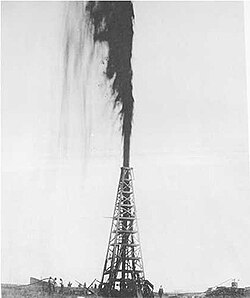Spindletop
|
Spindletop
|
|

The Lucas gusher at Spindletop, January 10, 1901. This was the first major gusher of the Texas Oil Boom.
|
|
| Location | Spindletop Hill, south of Beaumont, Texas, US |
|---|---|
| Coordinates | 30°1′9″N 94°4′26″W / 30.01917°N 94.07389°WCoordinates: 30°1′9″N 94°4′26″W / 30.01917°N 94.07389°W |
| Built | 1900 |
| NRHP Reference # | 66000818 |
| Significant dates | |
| Added to NRHP | November 13, 1966 |
| Designated NHL | November 13, 1966 |
Spindletop is a salt dome oil field located in the southern portion of Beaumont, Texas in the United States. The Spindletop dome was derived from the Louann Salt evaporite layer of the Jurassic geologic period. On January 10, 1901, a well at Spindletop struck oil ("came in"). The Spindletop gusher blew for nine days at a rate estimated at 100,000 barrels (16,000 m3) of oil per day.Gulf Oil and Texaco, now part of Chevron Corporation, were formed to develop production at Spindletop.
The frenzy of oil exploration and the economic development it generated in the state became known as the Texas oil boom. The United States soon became the world's leading oil producer.
There has been oil around Texas for a long time. Native Americans thought drinking oil would cure digestive problems. In 1543, Spanish explorers used oil to waterproof their boots.
There had long been suspicions that oil might be under "Spindletop Hill." The area was known for its vast sulfur springs and bubbling gas seepages that would ignite if lit. In August 1892, George W. O'Brien, George W. Carroll, Pattillo Higgins and others formed the Gladys City Oil, Gas, and Manufacturing Company to do exploratory drilling on Spindletop Hill. The company drilled many dry holes and ran into trouble, as investors began to balk at pouring more money into drilling with no oil to show for it.
Pattillo Higgins left the company and teamed with Captain Anthony F. Lucas, the leading expert in the U.S. on salt dome formations. Lucas made a lease agreement in 1899 with the Gladys City Company and a subsequent agreement with Higgins. Lucas drilled to 575 feet (180 m) before running out of money. He secured additional funding from John H. Galey and James M. Guffey of Pittsburgh, but the deal left Lucas with only an eighth share of the lease and Higgins with nothing.
...
Wikipedia

